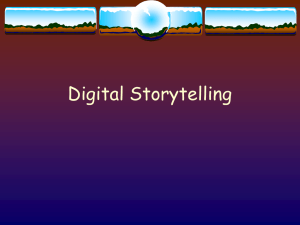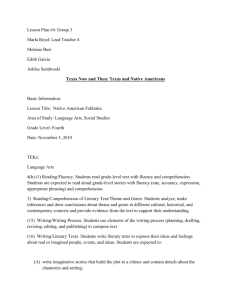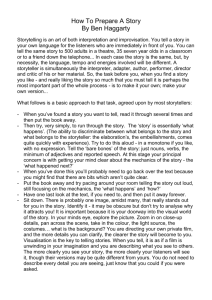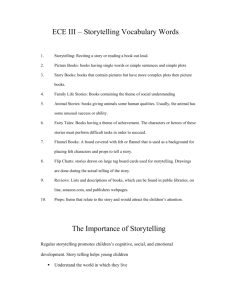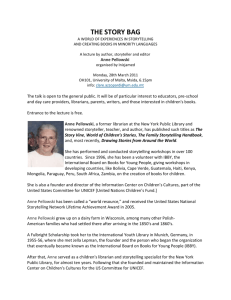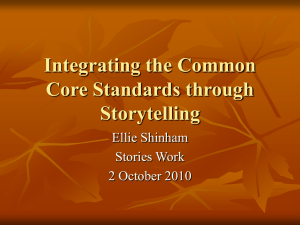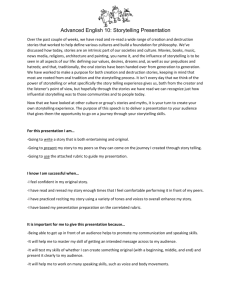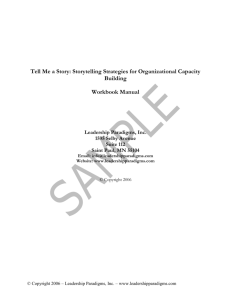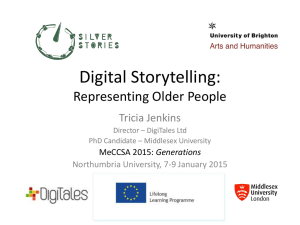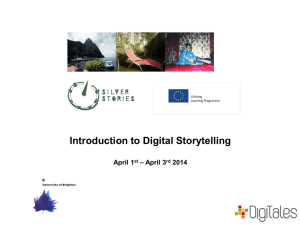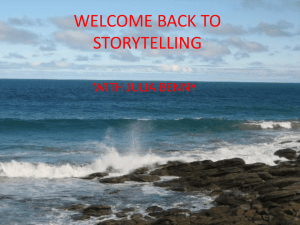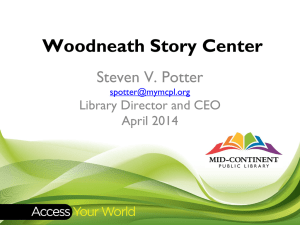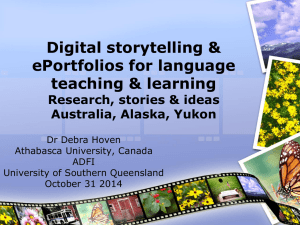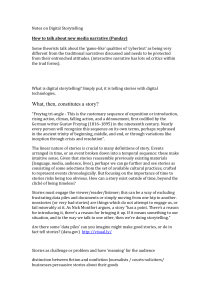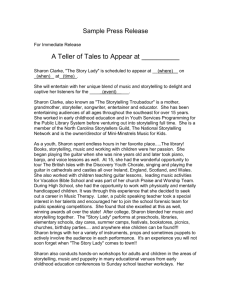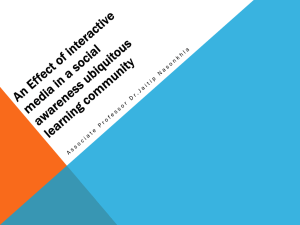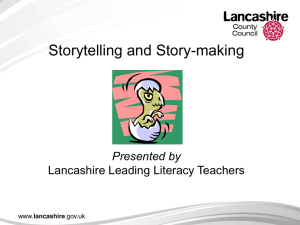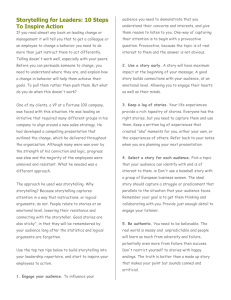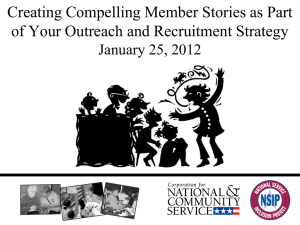Storytelling as a teaching strategy in the language classroom
advertisement
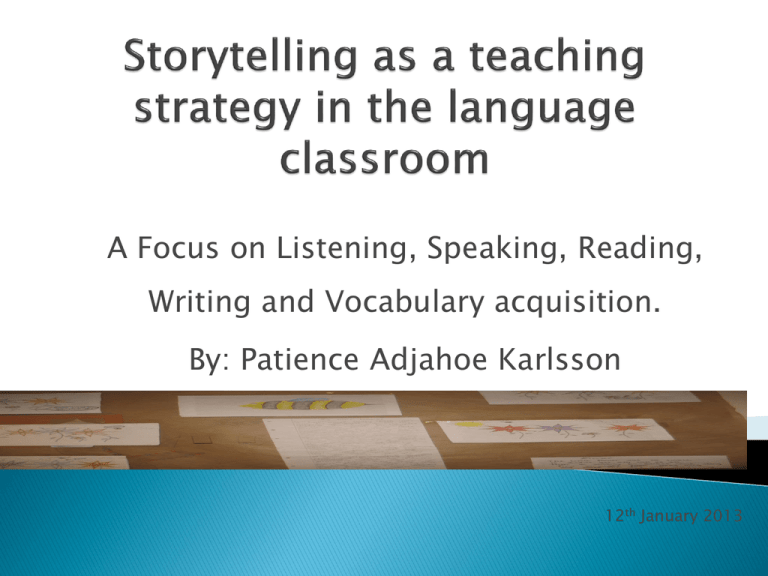
A Focus on Listening, Speaking, Reading, Writing and Vocabulary acquisition. By: Patience Adjahoe Karlsson 12th January 2013 Introduction Why Mother Tongue Education (MTE)? Why Storytelling? Storytelling to enhance Listening Skills Storytelling- Speaking Skills Storytelling- Reading Storytelling-Writing Storytelling-Vocabulary Acquisition Conclusion My Background- Ghana and thesis My interest in Storytelling A strong believe in the method-storytelling Me and Moðurmálskóli Expectations of Workshop: Interactive Short breaks-Exercises We would have fun Can always contact and/or invite me for further workshop if needed-through Kriselle 1. 2. 3. 1. 2. 3. 4. Why we should we teach mother tongue? Research show that; Children with strong foundation in their mother tongue tend to do better in the later years of their education MTE-Inclusion of guided transition from learning through MTE to learning through another language Cultural and Ethnic Identity How? Teaching/Learning-entirely in child’s home language Build fluency in MTE- Introduce oral (storytelling) in L2 (e.g. English or Icelandic depending on the children’s ability) Build oral fluency in L2. Introduce literacy in L2 Use both L1 and L2 for life long learning Is part of who we are Means of passing knowledge, skills and information since beginning of time Stories important in mother tongue-culturally based Children(if not all humans) enjoy listening and telling to stories They are familiar with narrative conventions They can make predictions about what will happen next (hence enhancing on their thinking & imaginative ability). Ideal introduction to the Pilipino-as it will help present the language in a familiar (e.g. Icelandic) and memorable context. Stories are very motivating, challenging and great fun for children. They can help develop positive attitudes towards the language, the culture and language learning on a whole” Autonomous and involves all aspects of Multiple Intelligence Fun- helpful Practice-tell your colleagues, friends, co-teachers stories. Notice the reactions of others to your stories-keep eye contact to gauge the impact of your stories Relevancy of story Stories must have a beginning, middle and end. Use pros, sounds and visual tools Consider the age group of your storytelling class and select suitable theme. Access the needs of specific age group and plan accordingly Give explanation &structure to children- reading materials, hand-outs to adults Teach storytelling techniques Give constructive feedback Listening to stories helps children become aware of the rhythm, intonation and pronunciation of language. Sharing of social experience-it provokes a shared response of laughter, sadness, excitement and anticipation which is not only enjoyable but can help to build up the child’s confidence and encourage social and emotional development. Teaching learning aids: Audio tapes, internet, books (with pictures),slides or just a story Beneficial to sit in a circle (enhances social interaction). If telling- clear voice, suitable gestures, music and dance. Dialog-Different voices for different characters Use voice to create atmosphere or tension as the story progress Use gestures and facial expression so children can visualise Pacing-Involve volume and rate of speaking Repetition and ExaggerationTeach children the techniques. Introduce lesson by telling about your self and encourage children to do same Let each child then introduce the next person sitting beside him/her Tell a story as a group 1. 1st person starts…… 2. Break for Practice Gather children in a circle around you(or chair). Close to each other (for better eye contact) Can place title on a board for children to see the written word To set children to thinking mode, begin story with a question (e.g. Have you ever tasted food from other country, how did you dis/like it?). As they answer, encourage them to listen to others answers (communication and listening-aha!). Try to use all the senses in a story. Encourage them to listen to the story, e.g. about what happened to Ananse Use home-based books.(Big books are better) Use communication skills like expression, phrasing, fluency, facial expression, emphasis of voice so children cam imitate when retelling the story. Break?????? Brainstorming activities. Beginning1. Catch the reader’s attention 2. • Make the opening dramatic 3. • Make the reader want to read on 4. • Take the reader straight into the story Middle 1. Keep the action going, develop the characters and story line. End1. Draw all the threads of the story together 2. Resolve any conflict within the story 3. Complete the telling of events Picture writing could be excellent way for younger children Take children for a walk within the school premises Let them observe and write down anything they see (if can’t write in L1, write in L2 then) Back in the classroom- Let them tell what they saw, in what mode was what they saw? Write vocabulary on board. If possible make a vocabulary folder with pictures of items saw and their names Storytelling can touch on all skills in language development It fun, creative and very effective Involves the use of the whole body (MI) Holistic teaching method Storytelling method provides huge space for fantasy and creativity. All language skills, functions and structures may be taught by stories. Storytelling method is an important teaching technique. Stories guide a human for his or her whole life and use them when the human learn his or her mother tongue. Consequently it is natural to learn a language with the help of stories.
